The Apple iPad Pro Review
by Ryan Smith, Joshua Ho & Brandon Chester on January 22, 2016 8:10 AM ESTBattery Life
Battery life is important beyond any doubt. No one wants a tablet or phone that can only spend three hours away from a charger before it dies, no matter how good the device is. While such battery life might be incredible for a desktop replacement or anything else that realistically spends most of its life plugged into a charger, mobile devices are usually carried on the go and used far away from a charger for significant amounts of time. Probably the ultimate example of this is travel, where one might use a tablet to watch movies and browse the internet for a few hours over the course of a flight.
As a result, a significant portion of our reviewing efforts are devoted to determining battery life. In order to quantify battery life, there are inevitably a lot of test cases to cover. Some people might spend most of their time in an e-reader app, others might spend most of their time playing games or similarly intensive tasks on their phones. There’s no real standard for usage, so a tablet that might last a day for one person could last a week. As a result, the goal of our testing is to provide a useful relative comparison. In order to do this, we attempt to equalize for variables like display brightness by setting all displays to 200 nits for battery life testing. Due to the inability to completely eliminate the variables that come with live network testing, we also use strong network reception with high throughput on LTE to ensure that things like power amplifiers are either at a low power setting or bypassed entirely.
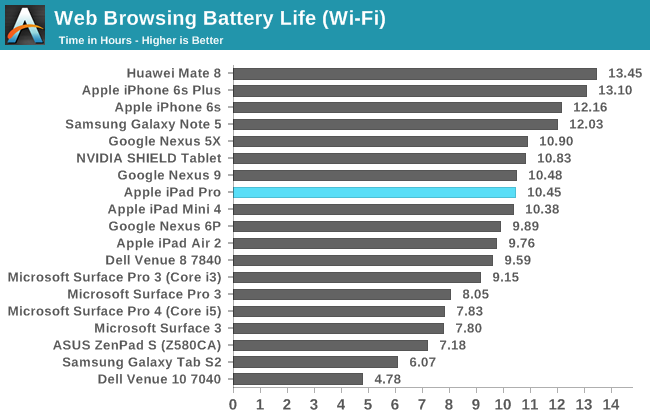
Our first test is the venerable web browsing test, in which we load a selection of web pages from full charge until the device shuts off from lack of battery charge. In WiFi battery life is pretty much identical to the iPad Air 2, which might be surprising given that the battery is only 41% larger. That might sound like a lot, but the display of the iPad Pro is 77% larger at the same 264 PPI pixel density, which means that there’s a pretty sizeable efficiency gap between the iPad Air 2 and iPad Pro. The improved display and SoC are likely to be the main reasons for this, as the 20nm SoC process that was used to make the A8 SoC was quite leaky due to its traditional planar transistor structure compared to the FinFET process used in the A9X.
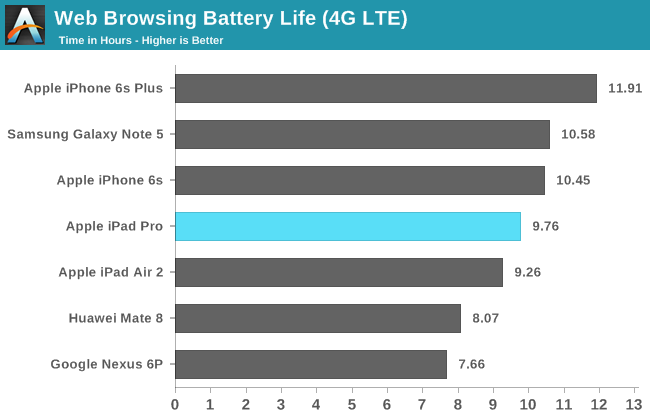
Interestingly, for whatever reason when re-running the same test on LTE battery life is noticeably different when compared to the iPad Air 2, where LTE and WiFi battery life were relatively close. I suspect that RF power is pretty similar between the two devices, but due to efficiency improvements on the display/SoC side the difference in battery life due to additional RF power consumption is magnified.

The more interesting test result that I encountered over the course of battery life testing was our tablet video rundown test. For whatever reason, web browsing clearly lasts a decent amount longer. It's pretty unlikely that the web browser has a lower SoC load when video is basically entirely dependent upon fixed function hardware decode. The most plausible explanation here for me is that we're seeing differences that arise from panel self-refresh, which can kick in on our web browsing test while the same definitely doesn't hold for our video test, which basically requires at least 30 FPS refresh rate continuously for the entire duration of the test. Overall that this makes the iPad Pro worse for content consumption, given Apple's content creation goals, is an unexpected turn of events.
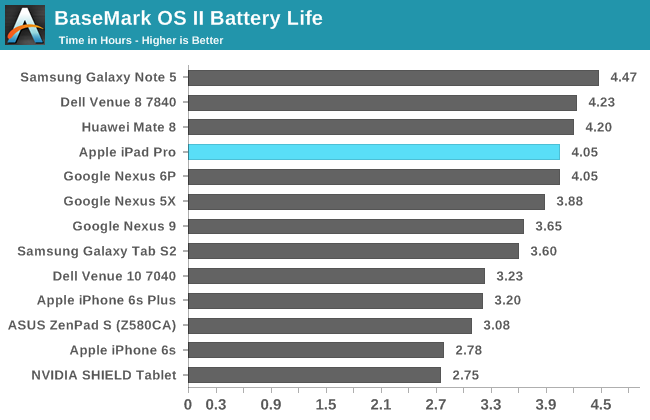
Moving on to the more SoC-bound tasks, we can start by looking at Basemark OS II, which is basically a CPU power virus that can be used to examine the upper bound for device TDP, in addition to nominal sustained CPU load. It’s evident from this test and some back of the envelope calculation that total device TDP excluding display power is roughly 5W, which is about right given the size of the device. This suggests that the A9X can be directly compared to Intel’s Core M in both performance and power, for better or for worse. Performance here is good, with relatively low throttling due to the use of a FinFET process and solid implementation of the Twister architecture.

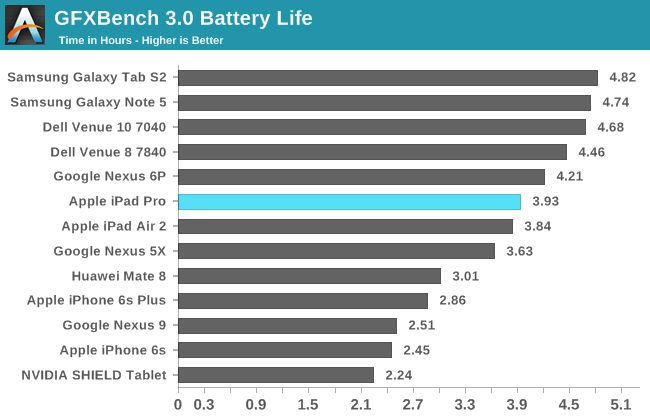
In our GPU throttling test, the A9X has effectively made it impossible to actually use T-Rex as a throttling test as it’s essentially pegged at vsync for the entire duration of the test. The iPad Pro also lasts a similar amount of time here as on the Basemark OS II test, which suggests that this test is still reaching TDP limits for the GPU, even if it doesn't manifest in the form of reduced performance.
Charge Time
While battery life is important, any time you’re dealing with a mobile device the time it takes to charge the battery is important as well. The usual example here is travel, but simply forgetting to plug in a device overnight can show the importance of charge rate. In the case of the iPad Pro, Apple ships it with their usual 12W charger. One might be tempted to suggest that the battery would be charged in about 3.5 hours, but it’s necessary to get the data and avoid speculation on something like this. In order to test how quickly the iPad Pro charges, we measure the difference in time between first plugging in a fully discharged tablet and when the charge is complete based upon power draw at the AC adapter.
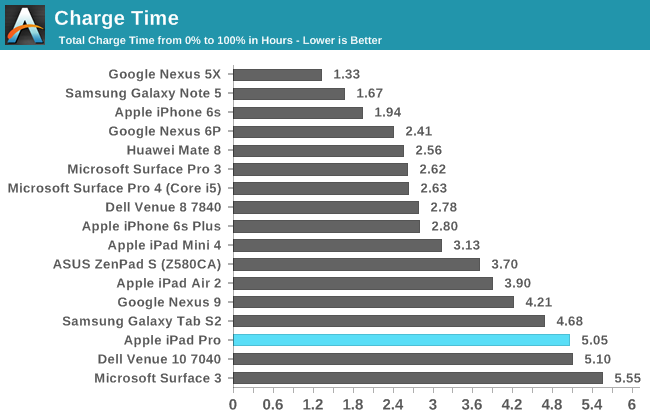
Interestingly, the iPad Pro takes a pretty significant amount of time to charge, at over a full hour longer than the iPad Air 2. While some might be okay with this, it’s definitely a sore spot for the iPad Pro as a higher voltage charger would be able to charge the device at a more acceptable rate. I’m not really sure why Apple decided to go this route, but there’s really no clear solution here unlike the case of the iPhone 6s Plus. The charger also definitely isn’t enough to ensure that you’re always charging the iPad Pro while in use either if the SoC is in overdrive/turbo states as thermally constrained power draw is already around 9-10W.
Despite the long charge time, overall the iPad Pro is quite mobile. However, it does regress somewhat relative to the iPad Air 2 due to its longer charge time, even if battery life is equivalent. Depending upon your use case though it might be difficult, if not impossible to tell the difference.











408 Comments
View All Comments
xerandin - Saturday, January 23, 2016 - link
In what way did Microsoft saw Surface Pro parts off of other products? You know what's better than that "most stable, secure, and highest quality mobile OS?" For most people, that would be Microsoft Windows--even if they love to complain about it, you can't deny Microsoft's ubiquity in the Professional space (and home userspace, too, but we're trying to keep this in the professional sector, right?)I've heard a few people at work say that the sysadmins love Macs (it was a Director obsessed with his Macbook telling me this), but I can't seem to find any of these supposed Mac-lovers. It could have something to do that they're a nightmare to administer for most sysadmins running a domain (which covers the vast majority of sysadmins), or the fact that Mac users tend to be just as inept and incapable as Windows users, so you get to have another pain-in-the-ass group of users to deal with on a system that just isn't very nice to administer.
If you take off your hipster glasses for a moment and actually use computers in the world we live in, there's no way around the reality that Microsoft wins in the Professional space--including their beautifully made, super-powerful Surface Pro.
And no, I'm not a Microsoft shill, I just can't stand Apple fanboys with more money than sense.
gistya - Sunday, January 24, 2016 - link
Xerandin, you have no idea what you are talking about. 90% of the professional software development studios I work with are almost solely Mac based, for the simple reason that they barely need an IT department at all, in that case.Windows is technical debt, plain and simple. It's legacy cruft stuck to the face of the world. The only IT guys that hate Macs are the idiot ones who don't know bash from tsch and couldn't sudo themselves out of a wet paper box. Then there are the smart ones who know that a shift to such a low maintenance platform would mean their department would get downsized.
But so many companies are stuck on crap like SAP, NovellNetware, etc., that Microsoft could literally do nothing right for 10 years and still be a powerhouse. Oh wait.
Apple hardware is worth every extra cent it costs, and then some; if you make such little money that $500 more on a tool that you'll professionally use 8-12 hours a day for three years is a deal-breaker, then I feel very sorry for you.
But personally I think it's more than worth it to have the (by far) best screen, trackpad, keyboard, case, input drivers, and selection of operating systems. I have five different OS's installed right now including three different versions of windows (the good one, and then the most recent one, and the one that my last job still uses, which does not receive security patches and gets infected with viruses after being on a website for 10 seconds).
As for the iPad Pro, all of you fools just don't understand what it is, or why the pencil is always sold out everywhere, or what the difference is. As a software developer I can tell you that there is the most extreme difference; and that more development for iOS is being done now than ever before, and is being done at an accelerating pace. This is just version 1.0 of the large-size, pro type model for Apple, and those of us who did not buy it yet and who are still waiting for that killer app, are basically saying that well, once that app comes out, then heck yes we'll buy it. Do you seriously believe that no company will rise up to capitalize on that obviously large market? Someone will, and frankly lets hope it's not Adobe.
I regularly see iPad pros now in the hands of the professional musicians and producers I work with, and they are most certainly using them for professional applications. That's a niche to be sure, but everyone who thinks that the surface pro 4 (a mildly crappy laptop with a touchscreen that makes a bad, thick tablet and an underpowered, overheated laptop) is even remotely in the same category of device, is utterly smoking crack.
doggface - Sunday, January 24, 2016 - link
I think it might be you smoking the crack there mate. Cor, what a rant. Microsoft are pretty safe in enterprise and it has everything to do with managing large networks(1000s not 10s of computers.. Please, direct me to Apple's answer to sccm, please show me Apple's answer to exchange. Please show me an Apple only environment running 1000 different apps outside ofGoogle and Apple HQ. Just aint haopening.Constructor - Sunday, January 24, 2016 - link
IBM (yes, the IBM!) has just announced that they will switch over to Macs a while ago. And they're neither the first nor the last. Springer (a major german media company) had done that a while ago already for similar reasons (removing unproductive friction and cutting the actual cost of ownership due to less needed user support).I know that many people had imagined that Windows would be the only platform anyone would ever need to know, but that has always just been an illusion.
damianrobertjones - Monday, January 25, 2016 - link
Link to the article please! They're THINKING of using Apple for mobile use... .Constructor - Monday, January 25, 2016 - link
Nope. They're massively ramping up Mac purchases as well, with a target of 50-75% Macs at IBM. They are already full steam ahead with it:http://www.i4u.com/2015/08/93776/ibm-purchase-2000...
(Okay: The official announcements don't have that aspect, but an internal video interview with IBM's CIO leaked to YouTube makes it rather explicit even so.)
One of the motivators is apparently that despite higher sticker prices the total cost of ownership is lower for Macs (which is not news any more, but having IBM arriving at that conclusion still says something).
Oxford Guy - Wednesday, January 27, 2016 - link
Gartner said in 1999 that Macs were substantially cheaper in TCO.mcrispin - Tuesday, January 26, 2016 - link
doggface, you speak with confidence where that confidence isn't deserved. I've managed deployments of OS X way over 10k, there are plenty of places with deployments this high. JAMF Casper Suite is the "SCCM of Apple", I don't need an "Apple" replacement for Exchange, 0365 and Google are just fine for email. There are plenty of non-Apple/Google Apps for OS X and iOS. You are seriously misinformed about the reality of the OS X marketplace. Shame that.Ratman6161 - Wednesday, January 27, 2016 - link
mcrispin...sure you can find individual shops that have done big MAC deployments. but its anecdotal evidence. Its like looking at one neigborhood in my city and from that conclude that trailer parks are the norm in my city of 15,000.Take a look at this Oct 2015 article on Mac market share (I'm assuming you dont consider Apple Insider to be a bunch of Microsoft shills?) http://appleinsider.com/articles/15/10/08/mac-gain...
While touting how Mac is gaining market share they show a chart where in Q32015 they were at 7.6%. The chart is by company and even smaller Windows PC vendors Asus and Acer are at 7.1 and 7.4 respectively. Throw in Lenovo, HP and Dell at 20.3%, 18.5%, 13.8% and the 25.3% "others" (and others are not MAC's because Apple is the only company with those).
So IBM is doing 50 - 75% Mac's? OK Ill take your word for that but so what? In the larger scheme of things Apple still has only 7.6% and selling some computers to IBM isn't going to siginificantly change that number. Also, don't forgot that some companies (that compete with Microsoft in various areas) will not use a Microsoft product no mater how good it was.
No matter how you look at it, Windows is the main stream OS for busineses world wide. Touting the exceptions to that doesn't cange the truth of it.
Constructor - Wednesday, January 27, 2016 - link
Of course most workplace computers now are PCs. The thing is just that Macs are making major inroads there as well.$25 billion in Apple's corporate sales are already very far removed from your theory (and that's even without all the smaller shops who are buing retail!).